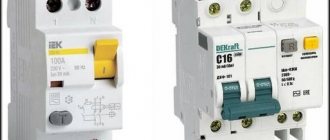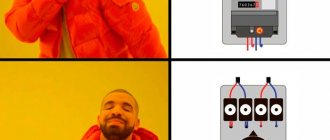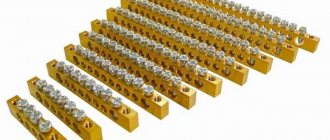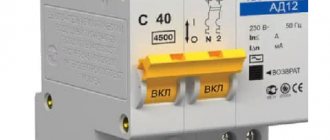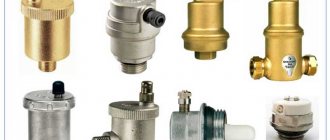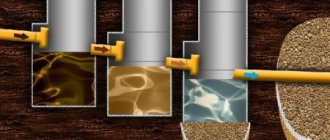In any case, it is impossible to do without protective elements of the electrical network in the apartment and in the country. These devices not only prevent serious consequences in the event of a short circuit and protect against exceeding permissible loads in the network, but also prevent current leakage. In most cases, circuit breakers, or “circuit breakers,” are used to protect devices from the consequences of a short circuit, while residual current devices (RCDs) are used to protect against possible leaks.
At the same time, both are well solved by combined devices, which have a mathematical name - differential circuit breakers, or “differential circuit breakers”. These are very convenient devices that combine two functions in one housing: an RCD and a circuit breaker.
What to install: difavtomat or RCD
Below we will briefly describe what both devices are, and also find out whether an RCD or a difavtomat, which one to choose. For now, it’s better to dwell on the main parameters of choice, which often act as limitations. This includes the price of the device, the inconvenience of connection and, of course, the size of the panel where you will install the device.
But the main criterion is still the purpose: why this or that device is installed. In particular, to ensure the safety of one consumer and one line, feel free to take a difavtomat.
At the same time, you need to remember that you will need to provide quite a lot of space in the shield for additional protection. As you know, for an RCD it is also necessary to install a circuit breaker, because it does not have built-in overcurrent protection. It turns out that the machine requires one module-place, and the RCD requires three (the module itself is twice as thick). The same applies to connecting outgoing lines, the number of which also depends on the number of groups of sockets.
Currently, you can already find on sale single-module difautomatic devices, which in terms of their functions are identical to conventional RCBOs: they have both an RCD and an automatic circuit breaker.
But RCBOs have a peculiarity when connecting, because involves the use of additional and very expensive tools such as press pliers, strippers and other tools that will reduce installation time.
Here the “UZO + automatic” option looks more budget-friendly and convenient.
In general, after this information it becomes clear what is better when choosing a difavtomat or an ouzo.
Select the release characteristic of the machine: “B” or “C”
The most popular differential models have the following release characteristics: “B” is the most popular option. Characterized by minimal response delay. Suitable for domestic use in houses with old wiring. Not recommended for networks supplying equipment with high starting currents (washing machines, pumps, refrigerators, concrete mixers, etc.). Short-term excess loads provoke the so-called. false alarm. Instantly triggers at currents equal to 3-5 rated; “C” is a universal option, a good solution for private homes. It has a longer delay before operation, so it does not respond to high inrush currents. It is recommended to select for networks with a large accumulation of powerful electrical equipment running on electric motors. Instantly triggers at a load 5-10 times higher than the rated load.
Type “B” is best used for lines without powerful consumers, and type “C” is more suitable for outlet lines with a load of 1 kW or more.
To maintain selectivity, it is advisable to set “C” at the input, and “B” at the outlet lines and lighting, so that in case of short circuits the input differential does not operate before the group ones.
How to connect an RCD and a difavtomat
The assembly of these devices is carried out in a standard way: the phase wire is connected to the circuit breaker, and then leaves the machine and is connected to the upper “phase” terminal of the RCD. The neutral wire is connected directly to the upper “zero” terminal of the RCD. Then the phase and zero move from the lower terminals of the RCD to the consumer.
The connection diagram for the difavtomat is a little simpler: the phase and neutral wires are connected directly to the upper terminals of the device. From the lower terminals the power goes to the consumer.
Unacceptable mistakes when purchasing
The device must be connected in accordance with the specified diagram
. To buy a high-quality automatic machine, it is important to avoid mistakes:
- Installing a device with a damaged housing - dents and cracks lead to breakdowns due to displaced internal components.
- Failed test in the store - the functionality of the devices is checked at special stands.
- Selection of the device is not according to the diagram - the machine will not correspond to the likely loads and will simply burn out.
- Using wires with an inappropriate cross-section - there may be risks of short circuits and burnouts of electrical appliances.
To choose the right differential device, you will need to study the markings, technical characteristics and carry out a test right in the store.
Features of application
As you know, it is necessary to install a protective device in an electrical circuit precisely for the purpose of protection: as a result of a power surge or other emergency situations, it turns off the power using special technologies. As a result of such an operation, the technician will have to find the cause of the shutdown, which may include either a short circuit or a current leak. In the case of using RCBOs, such reasons may not be immediately detected.
But when using the “automatic device + RCD” combination, you will immediately see: if the RCD turns off, the fault lies in a current leak, but if the circuit breaker trips, then the reason is a short circuit or line overload.
Breaking
There is no technology without problems. Everyone may experience them from time to time. The main thing is that this is found and corrected in time. Two-pole automatic machines are no exception in this regard.
A common problem occurs in thermal releases. It may stop working under any light load. This is very difficult for ordinary people without special education to identify. Therefore, almost all breakdowns are directly related to calling an electrician. There is no need to aggravate the situation on your own if you do not understand this issue.
What is an RCD
The RCD works as a human protector from electric shock and as a preventive mechanism to prevent accidental fire of wiring cables and connected cords of electrical appliances.
The functional idea of the device under consideration is based on the laws of electrical engineering, which postulate the equality of incoming and outgoing current in closed electrical circuits with active loads.
This means that the current flowing through the phase wire must be equal to the current flowing through the neutral wire - for single-phase current circuits with a two-wire wiring, and that the current in the neutral wire must be equal to the sum of the currents that flow in the phases for a three-phase four-wire circuit.
When in such a circuit, due to accidental human contact with non-insulated parts of the conductive elements of the circuit or when the exposed part of the wiring (due to damage) comes into contact with other conductive objects forming a new electrical circuit, a so-called current leakage occurs - the equality of the incoming and outgoing currents is violated .
This violation can be recorded and used as a command to shut down the entire electrical circuit. Based on this process, the RCD was designed. And the “leakage” current in the framework of electrical engineering began to be called differential current. An RCD can detect very small leakage currents and perform the functions of a switch mechanism.
When choosing an RCD, you need to remember that it does not provide internal protection against overcurrents; the RCD protects and reacts only to leakage current. Therefore, a circuit breaker must be installed in series with the residual current device. The rated current of the machine must be less than or equal to the rated current of the RCD.
Which release rating should I choose?
Based on the amount of leakage, difavtomats (like RCDs) are divided into two types:
- protecting against electric shock and fire (10-30 mA);
- fireproof (above 30 mA).
As a rule, sockets and lighting are protected by 30 mA diodes (the average person can withstand such a discharge). 10 mA is a safe value and absolutely harmless to the health and life of anyone, even a child. 10 mA difautomatic devices, as a rule, protect bathrooms and children's rooms.
They are not placed on socket groups, since electrical appliances with microcircuits can allow small differential leaks, giving a total of more than 10 mA, to which the differential can react. To protect only lighting or one outlet, this will be enough, the main thing is not to turn on extension cords with a large accumulation of consumers.
At least 30 mA is required at the input. For large houses they install 100 mA, but behind it, using the selectivity method, 30 mA and 10 mA difautomatic devices are installed, since not all people can withstand 100 mA.
How to distinguish an RCD from a difavtomat visually
Everything here is quite simple, although the two devices are very similar to each other. First of all, on the front side of the RCD you can see a powerful switch, an indicator and a “Test” button. Secondly, on the RCD on the body the current marking is indicated in large numbers, for example, 16A.
If at the beginning of the inscription there are the Latin letters B, C or D, and then there is a number, then this is a differential machine. For example, the current strength 16 is preceded by the letter “C”, which means the type of characteristic of the electromagnetic and thermal releases.
Technical device
Structurally, difavtomats are made of dielectric material. The rear part has a special mount for installation on a DIN rail. Inside, they consist of a two-pole or four-pole switch and a differential protection module connected in series with it. This module is a differential current transformer through which zero and phase pass, thereby forming the primary winding and the control winding - the secondary winding.
When the RCD does not protect
The RCD will not react when a person or animal comes under voltage, but no ground fault current will occur. This case is possible when touching simultaneously the phase and neutral conductors, which are under the control of an RCD, or when completely insulated with the floor. RCD protection in such cases is completely absent. An RCD cannot distinguish the electric current passing through the body of a person or animal from the current flowing in the load element. In such cases, safety can be ensured by mechanical protection measures (full insulation, dielectric casings, etc.) or complete de-energization of the electrical device before its technical inspection.
Therefore, the RCD is always connected in series with the machine. These two devices work in pairs: one protects against leaks, the other against overloads and short circuits.
Rating of the best AC class models
ABB DS201 2P 30 mA C
A good product that is suitable for placement in many apartments. The maximum leakage current is 30 mA. Produced by a popular company, so the quality is premium. The device has all the certificates and documents that confirm its safety, which is also a big plus.
The average price is 3,300 rubles.
ABB DS201 2P 30 mA C
Advantages:
- Reliability;
- Doesn't take up much space;
- Good build;
- Affordable price.
Flaws:
- Not detected.
Legrand DX3 2P 30 mA C
This automatic machine is reliable and safe. Therefore, a person can use the device without fear for his equipment. The body is made of durable plastic that can withstand minor mechanical loads. The breaking capacity is 6 kA.
Sold at a price of 1,980 rubles.
Legrand DX3 2P 30 mA C
Advantages:
- Low cost;
- Effective work;
- Reliable case;
- Quick shutdown.
Flaws:
- Not found.
IEK AVDT-32M 2P 10 mA C
Top product from a popular company. The product is equipped with reliable protective functions that will automatically work in the event of an unexpected situation. Works with voltages up to 230 V. The manufacturer equipped the device with a high-quality housing and increased the strength in the area where the conductors are connected; for this purpose, 9 rivets were created. The product warranty is 5 years, which is a long period and indicates to the buyer the trouble-free operation of this unit.
The average cost is 2,255 rubles.
IEK AVDT-32M 2P 10 mA C
Advantages:
- Easy installation and dismantling;
- Compactness;
- Strength;
- Convenient switch.
Flaws:
- Not detected.
Schneider Electric EASY 9 1P 30 mA C
If a person is looking for first-class quality at an affordable price and the best European assembly, then this is a suitable option. The product is suitable for most apartments. The manufacturer has equipped the machine with the best technical characteristics, which will increase the performance characteristics significantly.
The product is used in home networks, but also shows excellent results in production areas, which significantly increases the scope of its use.
The average price is 2,000 rubles.
Schneider Electric EASY 9 1P 30 mA C
Advantages:
- Efficiency;
- Good security;
- Wide scope of application;
- High quality build.
Flaws:
- Not detected.
IEK AD-12 2P 30 mA C
A cheap option that is reliable and safe. Despite the low price, the product will serve the owner for over 5 years, which is a positive thing. The protection class is IP20, so it is better to avoid installation in places with high humidity. Because this may cause the product to deteriorate and stop working. Produced by a popular company that is in great demand not only among homeowners, but also on production lines.
The body is made of durable plastic. It does not ignite in a fire and shows good resistance to temperature changes. Installation and dismantling of the machine will take a minimum of time. Compact dimensions and universal use also play a positive role when purchasing this model. Operates with voltages up to 230 V, with a leakage current of 30 mA. Breaking capacity – 4.5 kA.
Sold at a price of 840 rubles.
IEK AD-12 2P 30 mA C
Advantages:
- High service life;
- Low price;
- Efficiency;
- Quick shutdown in case of unforeseen circumstances;
- Durable housing.
Flaws:
- Not found.
EKF AD-12 Basic 2P 30 mA C
A good model designed for operation in networks where the rated voltage is 230 V. Protection class is IP20, which is the standard for such designs. The device meets European electrical safety requirements. The operating principle is electronic. The appearance is no different from previous models; the positive point is the ease of installation and removal, which makes it possible to easily replace the product in case of breakdown.
In addition, the difavtomat is small in size, which allows you to save more usable space in the distribution panel. Mechanical wear resistance is 20,000 cycles, so the device will serve the owner for decades and will not break at the wrong time.
The average price is 700 rubles.
EKF AD-12 Basic 2P 30 mA C
Advantages:
- Effective automatic shutdown when high loads and short circuits occur;
- The quality meets international standards;
- Saves useful space;
- Proven design.
Flaws:
- Not detected.
Finance
The cornerstone in such cases is always the financial issue. It has already ruined quite a few buyers who wanted to save money, and then were forced to pay several times more for all the damaged equipment. Almost all modern electrical appliances are quite reliable. They have guaranteed long terms of work.
Cable VVG-Png(A)-LSLTx- In what cases is a diesel generator needed: tips for choosing
- Automation shields: use
Do not forget to leave money for all installation work. This is sometimes more important than a more expensive and functional device. Why a RCBO might trip is known to any electrician. If you are familiar with electrical engineering, you can also easily distinguish that only the RCD is broken.
If you have a large and high-quality shield with free space, then you should fill it to the maximum, and not save space. Always leave in reserve, but excessive saving is also harmful.
Distribute everything into groups so that you can clearly see what belongs to what. Additional 20-30 modules there cost only about 500 rubles - this is not the place where you need to cut the budget.
